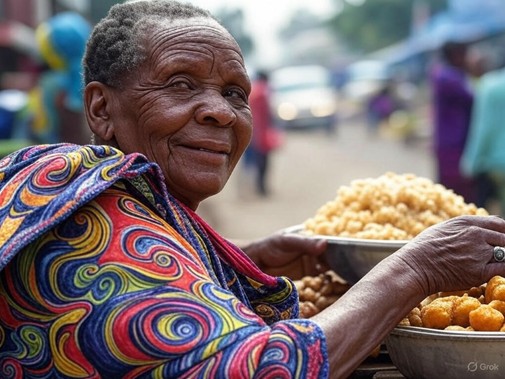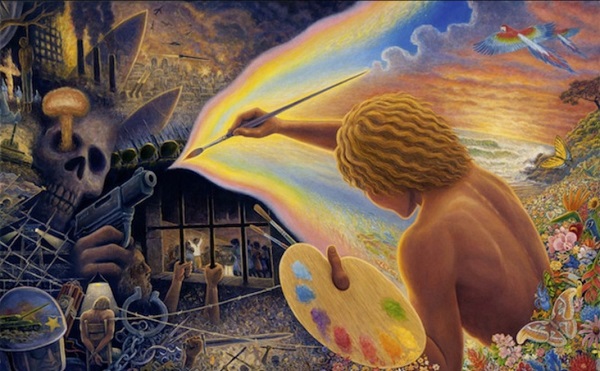Tariq Saeedi
“Peace is not about dodging a fight or waving a white flag. It’s about standing your ground, knowing your strength, and choosing not to swing,” said Mama Wanjiru.
“Peace doesn’t flinch; Peace is the real strength,” she added forcefully, as she splashed a ladle of stewed vegetables on my plate of ugali.
Mama Wanjiru sold home-cooked ugali, a kind of cornmeal porridge very popular and totally affordable, at a corner of Duruma Road in Nairobi. People flocked to her in equal parts for her delicious ugali and her barbed wisdom. She dispensed both generously. Everyone called her Shosho, granny in Kikuyu dialect. I called her Mama Wanjiru.
It was one of my last visits to Kenya and Uganda. My tumultuous career as a hides and skins merchant was about to collapse spectacularly, though I didn’t know it yet. As fate would have it, my syndicated column in the Leader, Star, and Daily News in Karachi was gaining some traction at that time, which helped my smooth transition into full-time journalism.
Whenever I write about peace, I recall that conversation with Mama Wanjiru some 30 years ago.
We live in a world that worships the loud—the tanks rolling, the fists raised, the voices shouting dominance. Power, we’re told, is a blade, sharp and quick. But what if power’s truest form is the refusal to cut? What if peace, far from weakness, is strength’s deepest root?
Strength isn’t always in the doing. Sometimes it’s in the ‘not doing.’ The pause. The breath before the storm. Gandhi didn’t march to the sea because he lacked a sword; he knew his weapon—peace—was sharper. Mandela didn’t choose reconciliation over revenge because he was frail; he saw that building a nation took more guts than burning one down.
There’s a line from Lao Tzu that haunts me: “Mastering others is strength; mastering yourself is true power.” Peace is that mastery. It’s the discipline to look at a provocation—a border skirmish, a shouted insult—and say, “I’m stronger than this.” It’s not cowardice. It’s control. A nation that chooses peace isn’t shrinking; it’s flexing a muscle most don’t even know they have.
But let’s be real: restraint isn’t crowd-puller. It doesn’t make headlines. A diplomat signing a treaty doesn’t get the same cheers as a general waving a flag. And yet, which one lasts? Which one plants the seed for a world that doesn’t choke on its own ash?
Here’s something to chew on:
- Peace is the way forward —not a retreat, but a current that carries nations forward if they dare ride it.
- Chasing the loud, quick win—think wars, think sanctions—often guts the long game. Look at Costa Rica, ditching its army in ’48. No military, yet it’s a global darling, thriving on education and green dreams. That’s not weak. That’s smart.
- Power loves to spend itself, like a fire eating its own fuel. Peace hoards its strength, banking it for when it counts.
- When peace is rare, its value soars. A nation that offers it—through diplomacy, through example—becomes a magnet, not a target.
Somehow, we’ve got this idea stuck in our heads: peace means soft, spineless, a doormat for the world’s boots. It’s an untruth we’ve bought wholesale. A peaceful nation isn’t one that can’t fight; it’s one that doesn’t need to. It’s the country that builds schools instead of bunkers, that negotiates trade deals instead of troop deployments, and still sleeps soundly knowing its borders are secure.
Take Switzerland. Neutral, sure, but weak? Hardly. Its mountains bristle with hidden defenses, its economy hums, its voice carries weight in global councils. Peace isn’t its surrender; it’s its shield. Or think of the Nordic countries, knitting alliances and prosperity while others rattle sabers. Their strength isn’t in what they destroy, but in what they create.
Peace is the expression of strength by non-violent, positive means. — Cyber defenses, economic resilience, assured prosperity that unites the nation against all threats, advancement in science and technology to counter any threats, and most importantly, equality, justice and fairness for all.
So why do we keep missing this? Why do we equate peace with giving up? Part of it’s cultural. We’re fed stories of heroes who conquer, not heroes who reconcile. Part of it’s practical—war is a blunt tool, easy to wield, while peace is a Swiss knife, versatile but tricky to master.
Here’s a thought: what if we redefined strength? Not as the ability to break, but to build. Not as the loudest voice, but the steadiest hand. Schools could teach this. Imagine kids learning not just history’s wars, but its peacetimes—how Iceland thrives without an army, how the EU, for all its flaws, keeps old enemies trading instead of fighting. Imagine leaders praising the quiet architects of stability, not just the firebrands.
And nations? They could start at the UN, debating what peace really means. Not some vague ideal, but a strategy. A global compact, maybe, where countries declare their red lines but commit to dialogue first. Sounds lofty, sure, but the UN Charter’s already a step that way. Why not build on it? A repository of intents, clear as day, so no one misreads a move and starts a war by mistake.
Peace isn’t a destination; it’s a discipline. It’s not weakness—it’s strength that knows its own weight. In 2025, as climate talks heat up and borders bristle, the nations that lean into peace won’t just survive; they’ll lead. They’ll be the ones others turn to when the shouting fails. — This is the year of ‘Peace and Trust.’
My salute to Mama Wanjiru. Her words are etched in my heart, “Peace is the real strength.” /// nCa, 21 April 2025 (Art by Grok and Journal of Future Studies)

